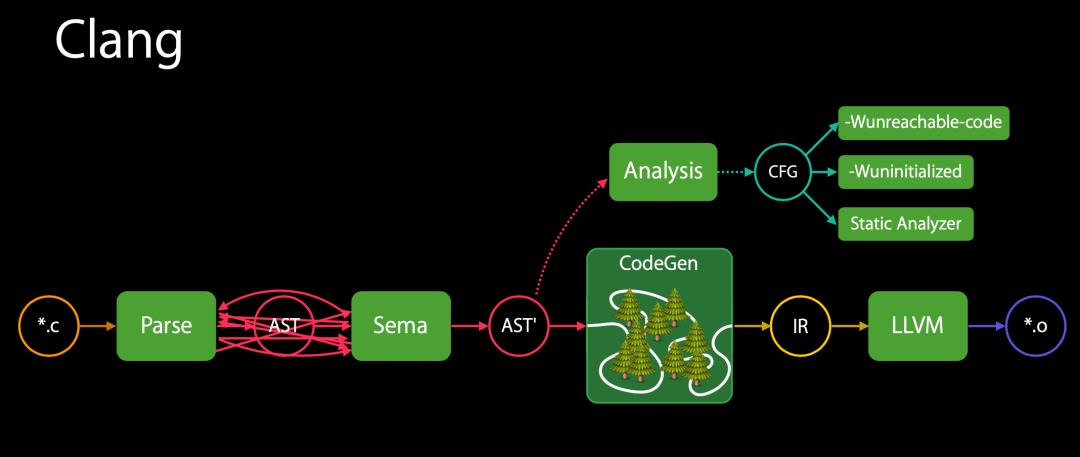Swift 编译器中间码 SIL
Posted 知识小集
tags:
篇首语:本文由小常识网(cha138.com)小编为大家整理,主要介绍了Swift 编译器中间码 SIL相关的知识,希望对你有一定的参考价值。
作者 | Roy
来源 | roy's blog,点击“阅读原文”查看作者更多文章
为什么要设计SIL

上图是传统的基于LLVM的编译器流程,比如C、C++以及Objective-C。代码分析主要是基于CFG(AST级别),CFG全称Control Flow Graph(函数流程控制图),是在clang这一层,但是这有很多缺点。
缺点:
源码和LLVM IR之间的巨大抽象差距不适用于源码级分析
CFG缺乏保真度
CFG不是在hot path上,hot path是指被多次迭代的代码块,图上可以看到不是在编译器流程的主路径上
CFG和IR降低中有很多的重复工作
Swift作为一种高级语言,有些高级特性,比如基于protocol的泛型。而且也是一门安全的语言,确保变量在使用之前被初始化、检测不可执行的代码(unreachable code)。于是为Swift编译器增加了一层SIL来做这些事情。
SIL
能够完全保留程序的语义
专为代码生成和分析而设计
在编译器流程的hot path上
弥补源码和LLVM之间的巨大抽象
SIL简介

Swift编译器在AST和LLVM IR之间有一个中间表示形式,称为SIL。通过使用访问者(Visitor)模式扫描AST来生成SIL。SIL会对Swift进行高级别的语意分析和优化。像LLVM IR一样,也具有诸如Module,Function和BasicBlock之类的结构。与LLVM IR不同,它具有更丰富的类型系统,有关循环和错误处理的信息仍然保留,并且虚函数表和类型信息以结构化形式保留。它旨在保留Swift的含义,以实现强大的错误检测,内存管理和高级优化。
同时像LLVM IR一样,SIL是静态单赋值Static-Single-Assignment (SSA),因此永远都不能重新定义值。当一条指令引用一个值时,该值要么是当前基本块的输入参数,要么由该块中的单个唯一指令定义。注意,与“真正的”编程语言不同,SIL是“扁平的”,因为在语法上没有嵌套的结构。每条指令引用其他指令产生的值,并对它们执行一个逻辑运算以产生新值。
相关代码:
/lib/SILGen
/lib/SIL
SSA
SSA 代表 static single-assignment,是一种IR(中间表示代码),要保证每个变量只被赋值一次。这个能帮助简化编译器的优化算法。
x = 0;
x = 1;
y = 2 * x;
比如上面这段代码,y = 1其实是不可用的,这个要通过定义的可达分析来确定y是要用1还是2,而SSA有一个标识符可以称之为版本或者”代”。
x1 = 0;
x2 = 1;
y = 2 * x2;
这样就没有任何间接值了。用SSA表示的好处是对于同一个变量的无关使用表示成不同”代”,可以方便很多编译器的优化算法的实现。
概括起来,SSA带来四大益处:
因为SSA使得每个变量都有唯一的定义,因此数据流分析和优化算法可以更加简单。
使用-定义关系链所消耗空间从指数增长降低为线性增长。若一个变量有N个使用和M个定义,若不采用SSA,则存在M×N个使用-定义关系。
SSA中因为使用和定义的关系更加的精确,能简化构建干扰图的算法。
源程序中对同一个变量的不相关的若干次使用,在SSA形式中会转变成对不同变量的使用,因此能消除很多不必要的依赖关系。
有了精确的对象使用–定义关系,许多利用使用–定义关系的优化就能更精确、更彻底、更高效。如
常数传播
死代码删除
全局
部分冗余删除
强度削弱
寄存器分配
关于SSA这里就不多讲了,还没深入研究过,之后可能会单独写篇文章讲一讲,另外推荐一本书Static Single Assignment Book。
SIL语言特点
单行指令,即一行表示一条指令
强类型
方法分解成连续的building-blocks(也就是BB)
包含ARC指令
专为代码分发而设计 *SIL寄存器数目是无限的,从%0,%1,%2这样递增
SIL结构
SIL程序是命名函数的集合,每个函数由一个或多个基本块组成。基本块是线性的指令序列,每个块中的最后一条指令将控制权转移到另一个基本块,或从函数返回。
Module
整个SIL源文件,中文叫模块,由SILFunction和SILGlobalVariable组成。可以通过begin() 和 end() 获得迭代器,通过迭代器可以快速遍历该模块中所有的函数。
using iterator = FunctionListType::iterator;
iterator begin() { return functions.begin(); }
iterator end() { return functions.end(); }
include/swift/SIL/SILModule.h https://github.com/apple/swift/blob/master/include/swift/SIL/SILModule.h
Function
包含函数定义和声明有关的所有对象。每个SILFunction由SILBasicBlock和SILArgument组成,可以看成是Swift函数的直接转换。通过isDefinition()可检查它是否是在本模块中声明的。这两种情况下都包含参数列表,可通过getArgument()来获得参数列表。
SILArgument *getArgument(unsigned i)
ArrayRef<SILArgument *> getArguments() const
Basic Block
SILBasicBlock由SILInstruction组成,是线性的指令序列,每个SILBasicBlock中的最后一条指令将控制权转移到另一个SILBasicBlock,或从函数返回。可通过begin() / end()访问SILInstruction。也可以使用getTerminator()方法直接访问最后一条指令。
TermInst *getTerminator()
Instruction
SIL中的基本单元,实际操作值或调用函数的指令。
SILValue和SILType
SILValue
SILValue定义了use_begin() 和 use_end()方法用于遍历User,或者通过getUses() 来获得所有User的范围,这对于迭代所有User很有用,如果要忽略调试信息指令,可以改用getNonDebugUses,通过这些方法可以简单访问它的def-use链。
inline use_range getUses() const;
SILType
/// True if the type is an address type.
bool isAddress() const { return getCategory() == SILValueCategory::Address; }
/// True if the type is an object type.
bool isObject() const { return getCategory() == SILValueCategory::Object; }
Metatype Types
SILType有很多种,元数据类型是其中一种,SIL中一个具体的元数据类型必须描述其表现形式
@thin,代表一个确切的具体类型,不需要存储。
@thick,描述元类型代表的形式,是引用一个对象类型或是其子类
@objc,代表使用Objective-C类对象表示,而不是纯Swift类型对象表示
type lowering
type lowering类型降级,我们平常在写swift中用到的系统提供的类型称为formal type,也就是正式类型。Swift的形式类型系统有意抽象了许多代表性的问题,例如所有权转移约定和参数的直接性。而SIL旨在代表大多数此类实现细节,这些差异应在SIL类型系统中得到体现,因此SIL type要丰富的多。从formal type到SIL type的转换的操作称为类型降级,SIL type又称为“lowered types”,降低的类型。
可以在/lib/SIL/IR/TypeLowering.cpp查看实现细节,主要方法是getLoweredType(),从正式类型返回SIL类型。
Builtin
因为下面例子中出现Builtin,所以这里稍微解释一下,采取Swift’s mysterious Builtin module文中一段话:
在Swift中,Int实际上一个struct,而+是一个针对Int重载的全局方法(global function)。严格说来,Int和+不是Swift语言的一部分,它们是Swift标准库的一部分。既然不是原生态,是不是就意味着操作Int或+的时候会有额外的负担,导致Swift跑得慢?当然不是,因为我们有Builtin。
Builtin将LLVM IR的类型和方法直接暴露给Swift标准库,所以我们在操作Int和+的时候,没有额外的运行时负担。
以Int为例,Int在标准库中是一个struct,定义了一个属性value,类型是Builtin.Int64。我们可以用unsafeBitCast将value属性在Int和Builtin.Int64之间相互转换。Int还重载了init方法,使得我们可以从Builtin.Int64直接构造一个Int。这些都是高效的操作,不会导致性能损失。
raw SIL 与 canonical SIL
SIL有两种形式,raw SIL(原始SIL) 和 canonical SIL(规范SIL),刚刚从SILGen中出来的未经优化的SIL称为raw SIL。
可以通过swiftc的-emit-silgen将Swift源码转变为raw SIL。
swiftc -emit-silgen Source.swift -o Source.sil
经过SIL Optimizer优化之后产生的优化SIL,称为规范SIL。可以通过swiftc的-emit-sil将raw SIL转变为canonical SIL。
swiftc Source.sil -emit-sil > Source-canonical.sil
也可以直接将Swift源码转变为canonical SIL。
swiftc Source.swift -emit-sil > Source-canonical.sil
例子讲解
来看一个最简单的例子
func test(number: Int) -> Bool {
if number > 0 {
return true
} else {
return false
}
}
使用一下swiftc命令转换成原始SIL,代码如下:
swiftc -emit-silgen Source.swift -o Source.sil
sil_stage raw
import Builtin
import Swift
import SwiftShims
func test(number: Int) -> Bool
// main
sil [ossa] @main : $@convention(c) (Int32, UnsafeMutablePointer<Optional<UnsafeMutablePointer<Int8>>>) -> Int32 {
bb0(%0 : $Int32, %1 : $UnsafeMutablePointer<Optional<UnsafeMutablePointer<Int8>>>):
%2 = integer_literal $Builtin.Int32, 0 // user: %3
%3 = struct $Int32 (%2 : $Builtin.Int32) // user: %4
return %3 : $Int32 // id: %4
} // end sil function 'main'
// test(number:)
sil hidden [ossa] @$s6Source4test6numberSbSi_tF : $@convention(thin) (Int) -> Bool {
// %0 // users: %8, %1
bb0(%0 : $Int):
debug_value %0 : $Int, let, name "number", argno 1 // id: %1
%2 = metatype $@thin Int.Type // user: %8
%3 = integer_literal $Builtin.IntLiteral, 0 // user: %6
%4 = metatype $@thin Int.Type // user: %6
// function_ref Int.init(_builtinIntegerLiteral:)
%5 = function_ref @$sSi22_builtinIntegerLiteralSiBI_tcfC : $@convention(method) (Builtin.IntLiteral, @thin Int.Type) -> Int // user: %6
%6 = apply %5(%3, %4) : $@convention(method) (Builtin.IntLiteral, @thin Int.Type) -> Int // user: %8
// function_ref static Int.> infix(_:_:)
%7 = function_ref @$sSi1goiySbSi_SitFZ : $@convention(method) (Int, Int, @thin Int.Type) -> Bool // user: %8
%8 = apply %7(%0, %6, %2) : $@convention(method) (Int, Int, @thin Int.Type) -> Bool // user: %9
%9 = struct_extract %8 : $Bool, #Bool._value // user: %10
cond_br %9, bb1, bb2 // id: %10
bb1: // Preds: bb0
%11 = integer_literal $Builtin.Int1, -1 // user: %14
%12 = metatype $@thin Bool.Type // user: %14
// function_ref Bool.init(_builtinBooleanLiteral:)
%13 = function_ref @$sSb22_builtinBooleanLiteralSbBi1__tcfC : $@convention(method) (Builtin.Int1, @thin Bool.Type) -> Bool // user: %14
%14 = apply %13(%11, %12) : $@convention(method) (Builtin.Int1, @thin Bool.Type) -> Bool // user: %15
br bb3(%14 : $Bool) // id: %15
bb2: // Preds: bb0
%16 = integer_literal $Builtin.Int1, 0 // user: %19
%17 = metatype $@thin Bool.Type // user: %19
// function_ref Bool.init(_builtinBooleanLiteral:)
%18 = function_ref @$sSb22_builtinBooleanLiteralSbBi1__tcfC : $@convention(method) (Builtin.Int1, @thin Bool.Type) -> Bool // user: %19
%19 = apply %18(%16, %17) : $@convention(method) (Builtin.Int1, @thin Bool.Type) -> Bool // user: %20
br bb3(%19 : $Bool) // id: %20
// %21 // user: %22
bb3(%21 : $Bool): // Preds: bb2 bb1
return %21 : $Bool // id: %22
} // end sil function '$s6Source4test6numberSbSi_tF'
// Int.init(_builtinIntegerLiteral:)
sil [transparent] [serialized] @$sSi22_builtinIntegerLiteralSiBI_tcfC : $@convention(method) (Builtin.IntLiteral, @thin Int.Type) -> Int
// static Int.> infix(_:_:)
sil [transparent] [serialized] @$sSi1goiySbSi_SitFZ : $@convention(method) (Int, Int, @thin Int.Type) -> Bool
// Bool.init(_builtinBooleanLiteral:)
sil [transparent] [serialized] @$sSb22_builtinBooleanLiteralSbBi1__tcfC : $@convention(method) (Builtin.Int1, @thin Bool.Type) -> Bool
第一个是main函数,这里就不讲了。从test(number:)看起
sil hidden [ossa] @$s6Source4test6numberSbSi_tF : $@convention(thin) (Int) -> Bool {
.....
}
这是一个SILFunction,里面包含三个SILBasicBlock,分别是bb0、bb1、bb2和bb3。
方法名s6Source4test6numberSbSi_tF,是test(number:)经过命令重整之后的。SIL中的标识符名称以@符号开头。
convention(thin) (Int) -> Bool,convention(thin)表示是Swift的函数调用,参数为Int类型,返回值为Bool类型。
bb0(%0 : $Int):
debug_value %0 : $Int, let, name "number", argno 1 // id: %1
%2 = metatype $@thin Int.Type // user: %8
%3 = integer_literal $Builtin.IntLiteral, 0 // user: %6
%4 = metatype $@thin Int.Type // user: %6
// function_ref Int.init(_builtinIntegerLiteral:)
%5 = function_ref @$sSi22_builtinIntegerLiteralSiBI_tcfC : $@convention(method) (Builtin.IntLiteral, @thin Int.Type) -> Int // user: %6
%6 = apply %5(%3, %4) : $@convention(method) (Builtin.IntLiteral, @thin Int.Type) -> Int // user: %8
// function_ref static Int.> infix(_:_:)
%7 = function_ref @$sSi1goiySbSi_SitFZ : $@convention(method) (Int, Int, @thin Int.Type) -> Bool // user: %8
%8 = apply %7(%0, %6, %2) : $@convention(method) (Int, Int, @thin Int.Type) -> Bool // user: %9
%9 = struct_extract %8 : $Bool, #Bool._value // user: %10
cond_br %9, bb1, bb2
这个简单的方法被分成4个代码块,bb0对应的是执行number > 0语句,bb1是对应if代码块,bb2对应else的代码块,bb3是return Bool代码块,接收一个Bool类型返回一个Bool类型。我们这里只分析bb0,其他的就不分析了。
这是一个SILBasicBlock。
bb0(%0 : $Int):%符号表示一个寄存器,这里第一个参数是Int类型,存放在%0。debug_value %0 : $Int, let, name “number”, argno 1 // id: %1:// id: %1是注释,说明分配的寄存器为%1。%2 = metatype $@thin Int.Type // user: %8:创建一个Int类型的的元类型对象,@thin表示该元类型不需要存储,因为它是精确类型。使用者是%8。%3 = integer_literal $Builtin.IntLiteral, 0 // user: %6:创建一个整数文字值,类型Builtin.IntLiteral,该类型必须为内置整数类型。文字值是使用Swift的整数文字语法指定的,值为0,使用者%8。%4 = metatype $@thin Int.Type // user: %6,创建一个Int类型的的元类型对象,@thin表示该元类型不需要存储,因为它是精确类型。使用者是%6。%5 = function_ref @$sSi22_builtinIntegerLiteralSiBI_tcfC : $@convention(method) (Builtin.IntLiteral, @thin Int.Type) -> Int // user: %6:function_ref是创建函数的引用,参数类型是Builtin.IntLiteral和 @thin Int.Type,返回值是Int,这个函数实际上是把整数文字值0转变成Int类型值0。%6 = apply %5(%3, %4) : $@convention(method) (Builtin.IntLiteral, @thin Int.Type) -> Int // user: %8:apply 调用函数,函数是 %5,传入参数是寄存器%3, %4),执行完返回结果存储在寄存器%8。%7 = function_ref @$sSi1goiySbSi_SitFZ : $@convention(method) (Int, Int, @thin Int.Type) -> Bool // user: %8:创建函数的引用,参数类型分别是Int, Int, @thin Int.Type,使用者是%8。%8 = apply %7(%0, %6, %2) : $@convention(method) (Int, Int, @thin Int.Type) -> Bool // user: %9:apply 调用函数为%7,传入参数是寄存器%0, %6, %2,执行完返回结果存储在寄存器%9 ;cond_br %9, bb1, bb2:cond_br是SILBasicBlock终止指令Terminators的一种,条件分支指令,如果%9是true,跳转到bb1,false跳转到bb2。其实就是if number > 0 的条件跳转。
SIL潜在用途
Swift热更新,Rollout就是通过在 SIL层给每个方法添加一个前缀来操作应用的
func add(a:Int, b:Int) -> Int {
if Rollout_shouldPatch(ROLLOUT_a79ee6d5a41da8daaa2fef82124dcf74) {
let resultRollout : Int =
Rollout_invokeReturn(Rollout_tweakData!,
target:self,
arguments:[a,
b,
origClosure: { args in return self.add(a:args[0],b:args[1]);});
return resultRollout;
在上面的代码中,Rollout_invokeReturn 负责执行一个从 Rollout 云下载的 javascript 函数。如果需要,该函数可以回调初始的方法。
Mutation tests,突变测试,又叫做“变异分析”,通常是改变代码中某个地方,测试程序是否能走到错误的代码逻辑。其实这个通过编译后端LLVM的JIT也可以,只是难度很大。
参考
[1] https://github.com/apple/swift/blob/tensorflow/docs/SIL.rst#sil-in-the-swift-compiler
[2] https://www.youtube.com/watch?v=Ntj8ab-5cvE
[3] https://benng.me/2017/08/27/high-level-sil-optimization-in-the-swift-compiler/
[4] https://medium.com/@slavapestov/how-to-talk-to-your-kids-about-sil-type-use-6b45f7595f43
[5] https://www.youtube.com/watch?v=M0iyooYWiFQ
[6] https://studygolang.com/articles/9361
[7] http://ankit.im/swift/2016/01/12/swift-mysterious-builtin-module/
[8] https://medium.com/@slavapestov/the-secret-life-of-types-in-swift-ff83c3c000a5
•
•
•
•
•
•
•
就差您点一下了
以上是关于Swift 编译器中间码 SIL的主要内容,如果未能解决你的问题,请参考以下文章